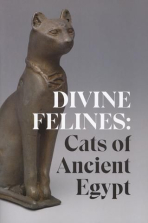
Seated Wadjet. From Egypt. Late Period, Dynasty 26 to Dynasty 31, 664–332 B.C.E. Bronze, 20 1⁄2 x 4 7⁄8 x 9 1⁄2 in. (52.1 × 12.4 × 24.1 cm). Brooklyn Museum, Charles Edwin Wilbour Fund, 36.622

Seated Wadjet. From Egypt. Late Period, Dynasty 26 to Dynasty 31, 664–332 B.C.E. Bronze, 20 1⁄2 x 4 7⁄8 x 9 1⁄2 in. (52.1 × 12.4 × 24.1 cm). Brooklyn Museum, Charles Edwin Wilbour Fund, 36.622

Striding Sphinx Finial. From Egypt. Third Intermediate Period, Dynasty 22 to Dynasty 24, circa 945–712 B.C.E. Bronze, 51⁄2 x 15⁄8 x 5 in. (14 × 4.1 × 12.7 cm). Brooklyn Museum, Charles Edwin Wilbour Fund, 61.20
Unlike images of the lion at rest, a striding sphinx represented protective aggression. The snakelike tail and extended legs of this sphinx identify him as the god Tutu. The falcon wings adorning his flanks place the sphinx in the solar realm, while the two cobras at his sides support Tutu’s power against evil.
This figure most likely was attached to a sacred boat used in temple rituals. It was meant to protect the boat and the divine statue contained inside.

Finial with Figure of the God Bes. Third Intermediate Period, Dynasty 21 to Dynasty 25, circa 1075–656 B.C.E. Bronze,1515⁄16 x 213⁄16 in. (40.5 × 7.2 cm). Brooklyn Museum, Charles Edwin Wilbour Fund, 46.127
Bes was popularly worshipped as protector of women and infants, and as a facilitator of fertility. The large, round ears and facial folds seen here are reminiscent of a snarling lion and connect Bes with powerful felines.

Cat with Kittens (detail). Reportedly from Saqqara, Egypt. Late Period to Ptolemaic Period, Dynasty 26 or later, circa 664–30 B.C.E. Bronze, solid-cast and wood, 23⁄8 x 37⁄16 x 115⁄16 in. (6.1 × 8.8 × 5 cm). Brooklyn Museum, Charles Edwin Wilbour Fund, 37.406E
The Egyptians associated the female cat’s fertility and motherly care with several divinities. The base of this statuette is inscribed with a request that Bastet grant life, directly linking the cat depicted here with the goddess Bastet. The kittens point to the benevolent aspect of this feline divinity, while her pointed ears emphasize the feline’s attentive vigilance and ability to protect her young.

Figure of a Cat. From Egypt. Ptolemaic Period–Roman Period, 305 B.C.E.–first century C.E. Wood, gilded gesso, bronze, rock crystal, glass, 259⁄16 x 65⁄16 x 1113⁄16 in. (65 × 16 × 30 cm). Brooklyn Museum, Charles Edwin Wilbour Fund, 37.1945E
Most cat statues of this type served as containers for cat mummies. Because this statue is solid, it must have functioned differently, perhaps as a temple offering. A scarab, symbolizing the morning sun, was frequently placed between the ears of such cats, perhaps an artistic interpretation of the stripes on a cat’s fur.

Cat’s Head. From Egypt. Roman Period, 30 B.C.E.–third century C.E. Bronze, gold, 23⁄8 x 13⁄4 x 113⁄16 in. (6 × 4.4 × 4.6 cm). Brooklyn Museum, Charles Edwin Wilbour Fund, 36.114
Glass or semiprecious stone inlays in the eyes once enhanced this cat’s lifelike appearance. The realistically rendered head also contains symbolic elements that are not immediately apparent; the incised details of fur on the ears evoke the shape of an ostrich feather, the hieroglyph for the goddess Maat—another daughter of the sun god Re, and the personification of truth and harmony.
Unlike simple loop earrings, which typically adorn cat’s heads like this one, these earrings follow the ornate style popular in Roman Egypt.

Leonine Goddess. From Egypt. Third Intermediate Period to Late Period, Dynasty 22 to Dynasty 27, C-14 dated to 770–412 B.C.E. Wood, gilding, plaster, linen, bronze,163⁄4 x 51⁄8 x 61⁄2 in. (42.5 × 13 × 16.5 cm). Brooklyn Museum, Charles Edwin Wilbour Fund, 37.1379E
The lion head, uraeus, and remains of a now missing sun disk of this goddess identify her as one of the daughters of the sun god. However, her unusual crouching pose, with both knees drawn up, and mummiform legs also connect her with Netherworld entities and guardian demons.
The statuette originally contained a cat mummy, the two together likely serving as a votive offering to a feline goddessThe lion head, uraeus, and remains of a now missing sun disk of this goddess identify her as one of the daughters of the sun god. However, her unusual crouching pose, with both knees drawn up, and mummiform legs also connect her with Netherworld entities and guardian demons. The statuette originally contained a cat mummy, the two together likely serving as a votive offering to a feline goddess..
Divine Felines: Cats of Ancient Egypt
July 24, 2013–November 29, 2015
From domesticated cats to mythic symbols of divinity, felines played an important role in ancient Egyptian imagery for thousands of years. Divine Felines: Cats of Ancient Egypt explores the role of cats, lions, and other feline creatures in Egyptian mythology, kingship, and everyday life through nearly thirty different representations of cats from our world-famous Egyptian collection. Likely first domesticated in ancient Egypt, cats were revered for their fertility, associated with royalty and a number of deities, and valued for their ability to protect homes and granaries from vermin.
On public view for the first time is a gilded Leonine Goddess (770–412 B.C.E.)—a lion-headed female crouching on a papyrus-shaped base—that entered our collection in 1937 and was conserved specially for this installation. The exhibition’s cats and feline divinities range from a large limestone sculpture of a recumbent lion (305–30 B.C.E.), to a diminutive bronze sphinx of King Sheshenq (945–718 B.C.E.), to a cast-bronze figurine of a cat nursing four kittens (664–30 B.C.E.). Also included are furniture and luxury items decorated with feline features.
Divine Felines: Cats of Ancient Egypt is organized by Yekaterina Barbash, Associate Curator of Egyptian Art, Brooklyn Museum.
